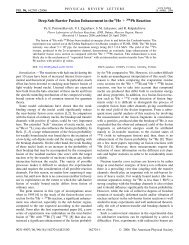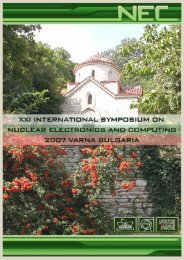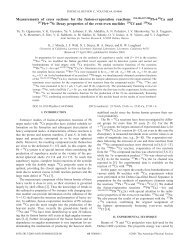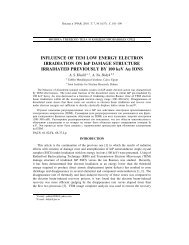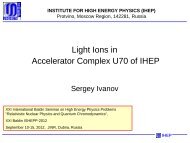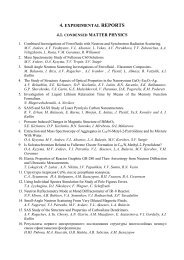The Czech Republic and JINR. Long-Term Fruitful
The Czech Republic and JINR. Long-Term Fruitful
The Czech Republic and JINR. Long-Term Fruitful
You also want an ePaper? Increase the reach of your titles
YUMPU automatically turns print PDFs into web optimized ePapers that Google loves.
All current systems use silicon as the detecting diode layer. Silicon is by far the most<br />
perfect <strong>and</strong> most available material, but has the great drawback that the stopping power for<br />
photons above 20 keV, an area of increasing importance at storage rings, is limited. Other<br />
fields of X-ray imaging, notably medical imaging, face the same problem. <strong>The</strong>refore, a lot of<br />
investments have been made for development of other materials that work at room<br />
temperature, like GaAs <strong>and</strong> Cd(Zn)Te.<br />
<strong>The</strong> medical imaging industry has mainly invested in Cd(Zn)Te, since for their main<br />
applications (humans) high energies, above 100 keV, are needed, which requires very high-Z<br />
sensors. However, despite the large efforts invested over the years, the material quality of<br />
Cd(Zn)Te, especially for large areas, is still far from perfect. In photon science there is a large<br />
<strong>and</strong> growing emphasis on the energy range up to 60 to 80 keV, for which GaAs is very well<br />
suited. A 300 micron thick, fully depleted GaAs sensor will give an order of magnitude<br />
improvement in quantum efficiency at 40 keV. An increased absorption of the sensor<br />
automatically gives a better shielding of the sensitive underlying CMOS readout electronics<br />
(ASIC) as well.<br />
<strong>The</strong> goals of this <strong>Czech</strong> (S.Pospíšil, I.Štekl, et al.) <strong>and</strong> <strong>JINR</strong> (G. Shelkov, A.<br />
Zhemchugov, V.Elkin, V.Kruchonok, D.Kharchenko) collaboration are the development of<br />
the necessary technology to produce GaAs-based hybrid pixel detectors <strong>and</strong> the construction<br />
of a large area pixellated detector.<br />
34



